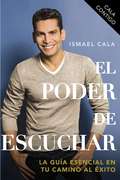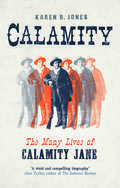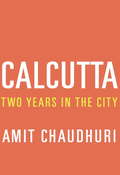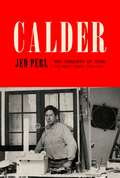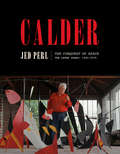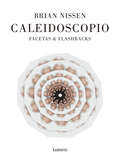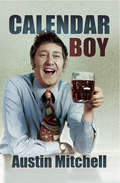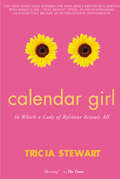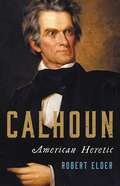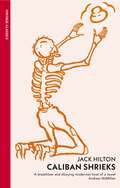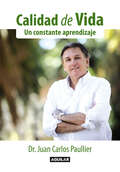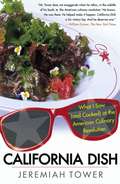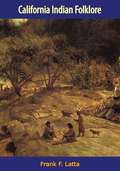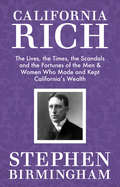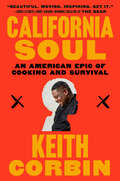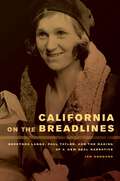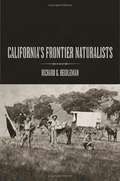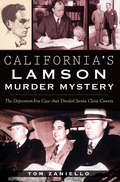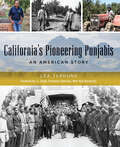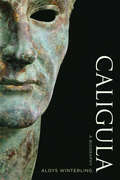- Table View
- List View
Cala Contigo: El Poder De Escuchar
by Ismael Cala"El secreto del buen hablar es saber escuchar". -Ismael Cala El célebre periodista y presentador de Cala, de CNN en Español, nos enseña a escuchar para evolucionar y mejorar nuestras vidas. Tras conversar con presidentes, intelectuales y celebridades de todos los campos, Cala nos confía la clave de su éxito como entrevistador: saber escuchar a los demás, para que compartan con nosotros cómo son y cómo piensan. Esta es también la clave para nuestro éxito en los negocios, el amor y las relaciones con todos los que nos rodean. Considerado el nuevo Larry King hispano, una de las muchas celebridades que comparecen por estas páginas, Cala nos brinda también un sinnúmero de consejos para escuchar nuestro cuerpo y nuestras verdaderas necesidades y sacar a la luz lo mejor de nosotros mismos. Que este libro sea el comienzo de una cadena para que tus padres, tus hijos, tus amigos, tus colegas, tus jefes e incluso los desconocidos con los que te cruces por la calle se conviertan en buenos escuchas, de los demás y de sí mismos. Desde su infancia en Cuba hasta su consagración en los medios de los Estados Unidos, el personaje público comparte con nosotros no sólo su lado más personal, sino también el largo camino que lo llevó a cultivar el "tercer oído", para penetrar en el alma de sus interlocutores y oír su propia voz interior. Con esta herramienta universal, que el autor nos regala a los lectores, pondremos el mundo a nuestros pies y haremos posibles nuestros sueños. ¿Estás listo para escuchar? .
Calamity Jane: Frontier Original (Legendary Heroes of the Wild West)
by Carl R. Green William R. SanfordBrings the action of the frontier days to life for the reluctant reader. Recounts the adventures of the explorers, pioneers, and settlers of the West.
Calamity: The Many Lives of Calamity Jane
by Karen R. JonesA fascinating new account of the life and legend of the Wild West’s most notorious woman: Calamity Jane Martha Jane Canary, popularly known as Calamity Jane, was the pistol-packing, rootin’ tootin’ “lady wildcat” of the American West. Brave and resourceful, she held her own with the men of America’s most colorful era and became a celebrity both in her own right and through her association with the likes of Wild Bill Hickok and Buffalo Bill Cody. In this engaging account, Karen Jones takes a fresh look at the story of this iconic frontierswoman. She pieces together what is known of Canary’s life and shows how a rough and itinerant lifestyle paved the way for the scattergun, alcohol-fueled heroics that dominated Canary’s career. Spanning Canary’s rise from humble origins to her role as “heroine of the plains” and the embellishment of her image over subsequent decades, Jones shows her to be feisty, eccentric, transgressive—and very much complicit in the making of the myth that was Calamity Jane.
Calcutta
by Amit ChaudhuriThe award-winning author Amit Chaudhuri has been widely praised for the beauty and subtle power of his writing and for the ways in which he makes "place" as complex a character as his men and women. Now he brings these gifts to a spellbinding amalgam of memoir, reportage, and history in this intimate, luminous portrait of Calcutta. Chaudhuri guides us through the city where he was born, the home he loved as a child, the setting of his acclaimed novels--a place he now finds captivating for all the ways it has, and, perhaps more powerfully, has not, changed. He shows us a city relatively untouched by the currents of globalization but possessed of a "self-renewing way of seeing, of inhabiting space, of apprehending life." He takes us along vibrant avenues and derelict alleyways; introduces us to intellectuals, Marxists, members of the declining haute bourgeoisie, street vendors, domestic workers; brings to life the city's sounds and smells, its architecture, its traditional shops and restaurants, new malls and hotels. And, using the historic elections of 2011 as a fulcrum, Chaudhuri looks back to the nineteenth century, when the city burst with a new vitality, and toward the politics of the present, finding a city "still not recovered from history" yet possessed of a singular modernity. Chaudhuri observes and writes about Calcutta with rare candor and clarity, making graspable the complex, ultimately ineluctable reasons for his passionate attachment to the place and its people.
Calder: 1898-1940
by Jed PerlThe first biography of America's greatest twentieth-century sculptor, Alexander Calder: an authoritative and revelatory achievement, based on a wealth of letters and papers never before available, and written by one of our most renowned art critics. Alexander Calder is one of the most beloved and widely admired artists of the twentieth century. Anybody who has ever set foot in a museum knows him as the inventor of the mobile, America's unique contribution to modern art. But only now, forty years after the artist's death, is the full story of his life being told in this biography, which is based on unprecedented access to Calder's letters and papers as well as scores of interviews. Jed Perl shows us why Calder was--and remains--a barrier breaker, an avant-garde artist with mass appeal. This beautifully written, deeply researched book opens with Calder's wonderfully peripatetic upbringing in Philadelphia, California, and New York. Born in 1898 into a family of artists--his father was a well-known sculptor, his mother a painter and a pioneering feminist--Calder went on as an adult to forge important friendships with a who's who of twentieth-century artists, including Joan Miró, Marcel Duchamp, Georges Braque, and Piet Mondrian. We move through Calder's early years studying engineering to his first artistic triumphs in Paris in the late 1920s, and to his emergence as a leader in the international abstract avant-garde. His marriage in 1931 to the free-spirited Louisa James--she was a great-niece of Henry James--is a richly romantic story, related here with a wealth of detail and nuance. Calder's life takes on a transatlantic richness, from New York's Greenwich Village in the Roaring Twenties, to the Left Bank of Paris during the Depression, and then back to the United States, where the Calders bought a run-down old farmhouse in western Connecticut. New light is shed on Calder's lifelong interest in dance, theater, and performance, ranging from the Cirque Calder, the theatrical event that became his calling card in bohemian Paris to collaborations with the choreographer Martha Graham and the composer Virgil Thomson. More than 350 illustrations in color and black-and-white--including little-known works and many archival photographs that have never before been seen--further enrich the story.
Calder: The Later Years: 1940-1976 (A Life of Calder #2)
by Jed PerlThe concluding volume to the first biography of one of the most important, influential, and beloved twentieth-century sculptors, and one of the greatest artists in the cultural history of America--is a vividly written, illuminating account of his triumphant later years.The second and final volume of this magnificent biography begins during World War II, when Calder--known to all as Sandy--and his wife, Louisa, opened their home to a stream of artists and writers in exile from Europe. In the postwar decades, they divided their time between the United States and France, as Calder made his first monumental public sculptures and received blockbuster commissions that included Expo '67 in Montreal and the 1968 Olympics in Mexico City. Jed Perl makes clear how Calder's radical sculptural imagination shaped the minimalist and kinetic art movements that emerged in the 1960s. And we see, as well, that through everything--their ever-expanding friendships with artists and writers of all stripes; working to end the war in Vietnam; hosting riotous dance parties at their Connecticut home; seeing the "mobile," Calder's essential artistic invention, find its way into Webster's dictionary--Calder and Louisa remained the risk-taking, singularly bohemian couple they had been since first meeting at the end of the Roaring Twenties. The biography ends with Calder's death in 1976 at the age of seventy-eight--only weeks after an encyclopedic retrospective of his work opened at the Whitney Museum in New York--but leaves us with a new, clearer understanding of his legacy, both as an artist and a man.
Caleidoscopio: Facetas & flashbacks
by Brian NissenUn divertido y perspicaz retrato de lugares y de gente encontrados en el camino del renombrado artista Brian Nissen. En este libro, el renombrado artista Brian Nissen cuenta sus andanzas en el mundo del arte. Un divertido y perspicaz retrato de lugares y de gente encontrados en su camino #entre otros, deambulan personajes como Nicanor Parra, Rufino Tamayo, Octavio Paz, Leonora Carrington y Dore Ashton. Caleidoscopio también nos regala agudas observaciones del autor acerca del arte contemporáneo, así como ensayos sobre arte y ciencia y el arte erótico. Pintor y escultor, Nissen ha expuesto su obra en museos y galerías por el mundo. Ha trabajado en el cine, realizado coreografías y pintado murales. Entre sus libros publicados se encuentran Expuesto, Limulus, Voluptuario, Farándula y Brian Nissen, una extensa monografía de su obra. Sus códices -reinterpretaciones de los antiguos libros mexicas realizados en el contexto del arte actual-, se encuentran en las bibliotecas de las universidades de Princeton y Harvard, el Museo de Arte Moderno de Nueva York y el Museo de Brooklyn. La crítica ha dicho... «Estamos ante un libro conversado que se beneficia del espontáneo witticism británico y la picardía mexicana. El título no puede ser más certero: en su papel de memorialista, Nissen no brinda las dilatadas secuencias de una vida; se concentra en escenas fundamentales, los vidrios de colores de un paisaje en movimiento.» Juan Villoro «Brian Nissen nos ofrece una visión múltiple del deseo. La perfección de su forma es su imperfección. Su arte no aspira conscientemente a la permanencia si ésta es el signo de la permanencia. Por eso, permanecerá» Carlos Fuentes «Nissen es un inventor de formas sólidas que de pronto, arrebatadas por un soplo entusiasta, se echan a volar: súbito polen multicolor» Octavio Paz «Brian Nissen ha establecido diálogos con los movimientos modernistas de mayor envergadura y ha encontrado inspiración estilística en todo aquello que pudiera haber congeniado con esa visión inconfundiblemente suya» Arthur Danto «Nissen diversifica entonces su tarea para establecer una fuente antropológica de gente, lugares y costumbres tradicionales. Y así como los artistas prehispánicos se refieren a todo lo concerniente a su existencia -la cocina, la medicina, el comercio, los cultos, el tiempo del calendario y el tiempo cósmico-, Nissen inventa una existencia» Dore Ashton
Calendar Boy
by Austin MitchellThese are the highly controversial memoirs of Austin Mitchell, local TV star of the 1970s and MP for Great Grimsby.Austin was the poster boy for Calendar TV at a time when local television had a much greater impact than national TV and its stars were the celebrities of the day. Austin charts his career path and reveals how he fell into his role at Yorkshire Television and went on to become its most popular presenter. He reveals the truth behind some of the most popular moments in TV history, including the infamous spat between Brian Cough and Don Revie. Austin also reveals the massive difference between the politically correct obsessed journalistic world of today and that of the 1970s.After his television career, Austin went on to serve as MP for Great Grimsby taking over the seat in 1977. He is still MP today, but has announced that he will not stand at the next general election.Calendar Boy will be a highly entertaining read for anyone who remembers the glory days of Calendar and wants to learn about the truth behind working life at a hugely popular TV prgramme that many tried to imitate but never bettered.
Calendar Girl: In Which A Lady Of Rylstone Reveals All
by Tricia StewartThe incredible true story of a small English village determined to raise money for cancer research—and the risqué calendar that became a global sensation. It was a crazy idea and good for a laugh when Tricia Stewart proposed a more risqué treatment for her local Women&’s Institute&’s annual calendar, which normally featured tranquil scenes from nature. Laughing alongside her was John Baker, the husband of the soon-to-be Miss February, Angela. When John passed away from cancer, the Ladies of Rylstone decided that posing nude for the calendar and donating the proceeds was one way to honor his memory and cope with this devastating loss. No one could have predicted what happened next. The calendar began to sell, and soon the whole world, it seemed, was interested in their story. In Calendar Girl, Tricia Stewart reveals the whole charming, heartwarming story as only she could.
Calhoun: American Heretic
by Robert ElderA new biography of the intellectual father of Southern secession—the man who set the scene for the Civil War, and whose political legacy still shapes America today.John C. Calhoun is among the most notorious and enigmatic figures in American political history. First elected to Congress in 1810, Calhoun went on to serve as secretary of war and vice president. But he is perhaps most known for arguing in favor of slavery as a "positive good" and for his famous doctrine of "state interposition," which laid the groundwork for the South to secede from the Union—and arguably set the nation on course for civil war.Calhoun has catapulted back into the public eye in recent years, as some observers connected the strain of radical politics he developed to the tactics and extremism of the modern Far Right, and as protests over racial injustice have focused on his legacy. In this revelatory biographical study, historian Robert Elder shows that Calhoun is even more broadly significant than these events suggest, and that his story is crucial for understanding the political climate in which we find ourselves today. By excising Calhoun from the mainstream of American history, he argues, we have been left with a distorted understanding of our past and no way to explain our present.
Caliban Shrieks: A rediscovered working-class masterpiece of British literature
by Jack Hilton'Witty and unusual' George Orwell'Magnificent' W H AudenA lyrical tour of life as a young working-class man born into the first days of the 20th century, Caliban Shrieks is a lost masterpiece of 1930s British literature.WITH NEW INTRODUCTIONS BY ANDREW McMILLAN AND JACK CHADWICKCaliban Shrieks’ narrator went from a childhood of poverty, yet joy and freedom, to the punishing grind of factory life and the idiocy of being sent blindly into war. He was turned out of the army a vagrant - seeing England from city to city, county to county - before being thrust back into an uncertain cycle of working life as it unfolded in the post-war years.A story of men and women lost, wandering – and angrily dreaming of a better, fairer England, Hilton’s autobiographical novel is a bold modernist retelling of the myth of how we find ourselves disenfranchised from the world and sold into a slavery of our making.Lost to time, only to be rediscovered again in the Salford's Working Class Movement Library in 2022, Caliban Shrieks is a working-class masterpiece of British literature, and continues to speak as brash and impassioned as it did on its first rave publication in 1935.
Calidad de vida
by Juan Carlos PaullierEsta es una historia inspiradora, pero además, es un libro que pretendebrindarle a los lectores, herramientas que los ayuden a mejorar su Calidad de Vida. En noviembre de 1993, un auto que iba a más de 100 kilómetros por horaimpactó con el vehículo donde viajaba el doctor Juan Carlos Paullier.Días después despertó postrado y sin la certeza de poder volver acaminar. Paullier decidió luchar por su vida y a partir de ese momentoya nada fue como antes. Desde entonces decidió transmitir su experienciaa los demás y trabajar por una vida más saludable. Esta es una historiainspiradora, pero además, es un libro que pretende brindarle a loslectores, herramientas que los ayuden a mejorar su Calidad de Vida.Aunque la recibimos sin pedirla ni ser consultados, la vida es un donque debemos preservar como un legado cuya calidad es derecho de todos yresponsabilidad de cada uno. Esta obra es testimonio de ello.La importancia de este libro radica en que, al tiempo de dar cuenta dememorias, experiencias, esperanzas y proyectos de su autor, expresa losvalores, principios y compromisos de Juan Carlos Paullier comoprofesional, como ciudadano y, sobre todo ?porque es tan fundamentalcomo la relación del árbol con su semilla? como ser humano.Al recorrer las páginas siguientes cada lector llegará a sus propiasconclusiones. Aun a riesgo de parecer imprudente, permítanme adelantar ycompartir con ustedes una de las mías: Calidad de Vida nos enseña que,como casi todo en la vida, a vivir también se aprende.Dr. Tabaré Vázquez (ex Presidente de Uruguay 2005-2010)
California Classics: Essays on the Books and Their Writers
by Lawrence Clark PowellEssays by 31 writers, from California, about California, or who at least passed through California and the books they wrote that have had some lasting impact on how California is viewed; from its discovery to the 1970s (when the book was published). Herbert E. Bolton, ANZA'S CALIFORNIA EXPEDITIONS; Walter Nordhoff, THE JOURNEY OF THE FLAME; William L. Manly, DEATH VALLEY IN '49; Mary Austin, THE LAND OF LITTLE RAIN; George Wharton James, THE WONDERS OF THE COLORADO DESERT; Louisa Smith Clapp, THE SHIRLEY LETTERS; Bret Harte, THE LUCK OF ROARING CAMP; Mark Twain, ROUGHING IT; Gertrude Atherton, THE SPLENDID IDLE FORTIES; William H. Brewer, UP AND DOWN CALIFORNIA IN 1860-64; Clarence King, MOUNTAINEERING IN THE SIERRA NEVADA; John Muir, THE MOUNTAINS OF CALIFORNIA; Richard Henry Dana, Jr., TWO YEARS BEFORE THE MAST; Robert Louis Stevenson, THE SILVERADO SQUATTERS; Frank Norris, MCTEAGUE; Jack London, MARTIN EDEN; Smeaton Chase, CALIFORNIA COAST TRAILS; Robinson Jeffers, GIVE YOUR HEART TO THE HAWKS; John Steinbeck TO A GOD UNKNOWN; Charis and Edward Weston, CALIFORNIA AND THE WEST; Idwal Jones, THE VINEYARD; Robert Glass Cleland, THE CATTLE ON A THOUSAND HILLS; Helen Hunt Jackson, RAMONA; Horace Bell, REMINISCENCES OF A RANGER; Charles E Lummis, LAND OF SUNSHINE; Lincoln Steffens, BOY ON HORSEBACK; Upton Sinclair, OIL!; Harry Leon Wilson, MERTON OF THE MOVIES; Nathanael West, THE DAY OF THE LOCUST; Aldous Huxley, AFTER MANY A SUMMER; Raymond Chandler FAREWELL, MY LOVELY.
California Dish: What I Saw (and Cooked) at the American Culinary Revolution
by Jeremiah TowerWidely recognized as the godfather of modern American cooking and a mentor to such rising celebrity chefs as Mario Batali, Jeremiah Tower is one of the most influential cooks of the last thirty years. Now, the former chef and partner at Chez Panisse and the genius behind Stars San Francisco tells the story of his lifelong love affair with food -- an affair that helped to spark an international culinary revolution. Tower shares with wit and honesty the real dish on cooking, chefs, celebrities, and what really goes on in the kitchen. Above all, Tower rhapsodizes about food -- the meals choreographed like great ballets, the menus scored like concertos. No other book reveals more about the seeds sown in the seventies, the excesses of the eighties, and the self-congratulations of the nineties. No other chef/restaurateur who was there at the very beginning is better positioned than Jeremiah Tower to tell the story of the American culinary revolution.
California Dreamin': The True Story of the Mamas and the Papas
by Michelle PhillipsIt's all here--the years of poverty, struggle, and obscurity... the fateful first meeting with record producer Lou Adler... the incredible burst of work and creativity that led to their first smash album... the band's meteoric rise to stardom ("Monday, Monday" sold 160,000 copies the first day it was released)... the wildly decadent life-style that embraced LSD and free love... the burnout, the arguments, and the final bitterness and breakup of the band.
California Indian Folklore
by Frank F. LattaCalifornia Indian Folklore, which was first published in 1936, is a fascinating book, well written, and full of interesting first hand lore of California’s Yokuts Indians. It is because Frank Latta was able to interview the last of the old tribal leaders that this book exists. Latta’s expertise in gaining information from the Yokuts has enabled us to preserve, in writing, some of their heritage.California Indian Folklore is a valuable resource on the life of the Yokuts of the San Joaquin Valley. The Yokuts, overall, were a happy people who made admirable use of the natural resources that surrounded them. It would make excellent first person quotes for exhibits or school study, even at the elementary level. The reader who has an interest in early California native ways will enjoy this historic volume.
California Rich
by Stephen Birmingham&“[A] downright intriguing history . . . chronicling of the creation of the Californian Dream.&” —Los Angeles Times Since the Gold Rush, California has represented a land of opportunity for a special breed of American. Heading west in pursuit of sunshine, riches, and elusive dreams, the early mavericks of California set out to make their fortunes—and often succeeded beyond their wildest imaginations. Prospectors became oil tycoons, squatters became cattle barons, and farmers&’ wives became grandees of a new rough-hewn society. In California Rich, Stephen Birmingham explores this fascinating social history, showing how the ruling class of California was born and how it evolved a lifestyle that continues to fascinate the world. Its colorful array of characters include: the despotic media mogul William Randolph Hearst; governor and railroad baron Leland Stanford; and real estate magnate James Irvine, who attended business meetings with an entire pack of hunting dogs. In exploring how these self-made millionaires acquired their money—and what they did with it—Birmingham sheds light on the customs and quirks of California wealth, and how the state came to symbolize the easy, opulent life that still entices seekers of fame and fortune today.
California Rich: The Lives, the Times, the Scandals, and the Fortunes of the Men & Women Who Made & Kept California's Wealth
by Stephen BirminghamCalifornia Rich is the entertaining and scandal-filled look inside the lives of the Golden State's moneyed elite.
California Soul: An American Epic of Cooking and Survival
by Kevin Alexander Keith CorbinA sharply crafted and unflinchingly honest memoir about gangs, drugs, cooking, and living life on the line—both on the streets and in the kitchen—from one of the most exciting stars in the food world today&“As compelling or more so than Boyz N the Hood and Menace II Society . . . When Corbin writes about his life, it burns with the intensity of the best pulp fiction, but it isn&’t fiction—it&’s the life he lived.&”—Los Angeles TimesChef Keith Corbin has been cooking his entire life. Born on the home turf of the notorious Grape Street Crips in 1980s Watts, Los Angeles, he got his start cooking crack at age thirteen, becoming so skilled that he was flown across the country to cook for drug operations in other cities. After his criminal enterprises caught up with him, though, Corbin spent years in California&’s most notorious maximum security prisons—witnessing the resourcefulness of other inmates who made kimchi out of leftover vegetables and tamales from ground-up Fritos. He developed his own culinary palate and ingenuity, creating &“spreads&” out of the unbearable commissary ingredients and experimenting during his shifts in the prison kitchen.After his release, Corbin got a job managing the kitchen at LocoL, an ambitious fast food restaurant spearheaded by celebrity chefs Roy Choi and Daniel Patterson, designed to bring inexpensive, quality food and good jobs into underserved neighborhoods. But when Corbin was suddenly thrust into the spotlight, he struggled to live up to or accept the simplified &“gangbanger redemption&” portrayal of him in the media. As he battles private demons while achieving public success, Corbin traces the origins of his vision for &“California soul food&” and takes readers inside the worlds of gang hierarchy, drug dealing, prison politics, gentrification, and culinary achievement to tell the story of how he became head chef of Alta Adams, one of America&’s best restaurants.
California on the Breadlines: Dorothea Lange, Paul Taylor, and the Making of a New Deal Narrative
by Jan GoggansCalifornia on the Breadlines is the compelling account of how Dorothea Lange, the Great Depression’s most famous photographer, and Paul Taylor, her labor economist husband, forged a relationship that was private—they both divorced spouses to be together—collaborative, and richly productive. Lange and Taylor poured their considerable energies into the decade-long project of documenting the plight of California’s dispossessed, which in 1939 culminated in the publication of their landmark book, American Exodus: A Record of Human Erosion. Jan Goggans blends biography, literature, and history to retrace the paths that brought Lange and Taylor together. She shows how American Exodus set forth a new way of understanding those in crisis during the economic disaster in California and ultimately informed the way we think about the Great Depression itself.
California's Frontier Naturalists
by Richard G. BeidlemanThis book chronicles the fascinating story of the enthusiastic, stalwart, and talented naturalists who were drawn to California's spectacular natural bounty over the decades from 1786, when the La Pérouse Expedition arrived at Monterey, to the Death Valley expedition in 1890-91, the proclaimed "end" of the American frontier.
California's Lamson Murder Mystery: The Depression Era Case that Divided Santa Clara County (True Crime)
by Tom ZanielloOn Memorial Day 1933, Stanford executive David Lamson found his wife, Allene, dead in their Palo Alto home. The only suspect, he became the face of California's most sensational murder trial of the century. After a judge sentenced him to hang at San Quentin, a team of Stanford colleagues stepped in to form the Lamson Defense Committee. The group included poets Yvor Winters and Janet Lewis, as well as the "Sherlock Holmes of Berkeley," criminologist E.O. Heinrich. They managed to overturn the verdict and incite a series of heated retrials that gripped and divided the community. Was Lamson the victim of aggressive prosecutors, or was he a master of deception whose connections helped him get away with murder? Author and Stanford alum Tom Zaniello meticulously examines the details of a notorious case with a lingering legacy.
California's Pioneering Punjabis: An American Story (American Heritage)
by Lea Terhune"…evocative vignettes and inspiring stories from many of California's South Asian American citizens…" Paul Michael Taylor, Director, Asian Cultural History Program, Smithsonian Institution.At the turn of the 19th and 20th centuries, adventurous travelers left the Punjab in India to seek their fortune in California and beyond. Laboring in farms, fields and orchards for low wages while enduring racial discrimination, they strove to put down roots in their new home. Bhagat Singh Thind, an immigrant who served in the United States Army, had his citizenship granted and revoked twice before a 1936 law expanded naturalization to all World War I veterans, regardless of race. Dalip Singh Saund obtained a master's degree and doctorate in mathematics from UC Berkeley only to return to farming when no one would hire him. In 1956, Saund went on to become the first Asian elected to the U.S. Congress. Ethnic South Asians are now found in every trade and profession in the United States, including the Office of the Vice President. Descendants of the first Punjabi immigrants from Yuba City to the Imperial Valley still farm, adding to the rich tapestry of the Central Valley.Author Lea Terhune recounts the risks, setbacks and persistence of the people who achieved their American dreams.
Californians
by James D. HoustonJames D Houston travels down the coast of California and records his experiences for others.
Caligula
by Paul Psoinos Aloys Winterling Deborah Lucas Schneider Glenn W. MostThe infamous emperor Caligula ruled Rome from A.D. 37 to 41 as a tyrant who ultimately became a monster. An exceptionally smart and cruelly witty man, Caligula made his contemporaries worship him as a god. He drank pearls dissolved in vinegar and ate food covered in gold leaf. He forced men and women of high rank to have sex with him, turned part of his palace into a brothel, and committed incest with his sisters. He wanted to make his horse a consul. Torture and executions were the order of the day. Both modern and ancient interpretations have concluded from this alleged evidence that Caligula was insane. But was he? This biography tells a different story of the well-known emperor. In a deft account written for a general audience, Aloys Winterling opens a new perspective on the man and his times. Basing Caligula on a thorough new assessment of the ancient sources, he sets the emperor's story into the context of the political system and the changing relations between the senate and the emperor during Caligula's time and finds a new rationality explaining his notorious brutality.
